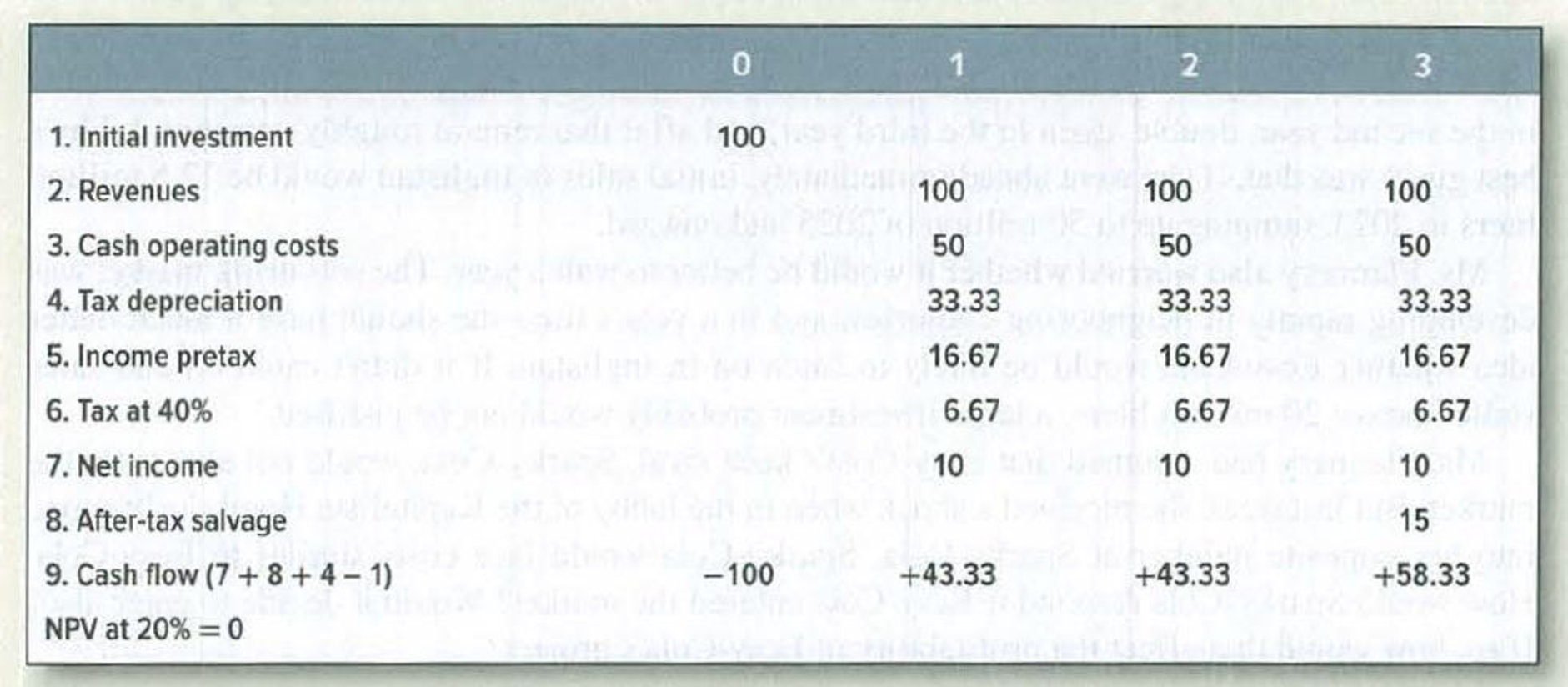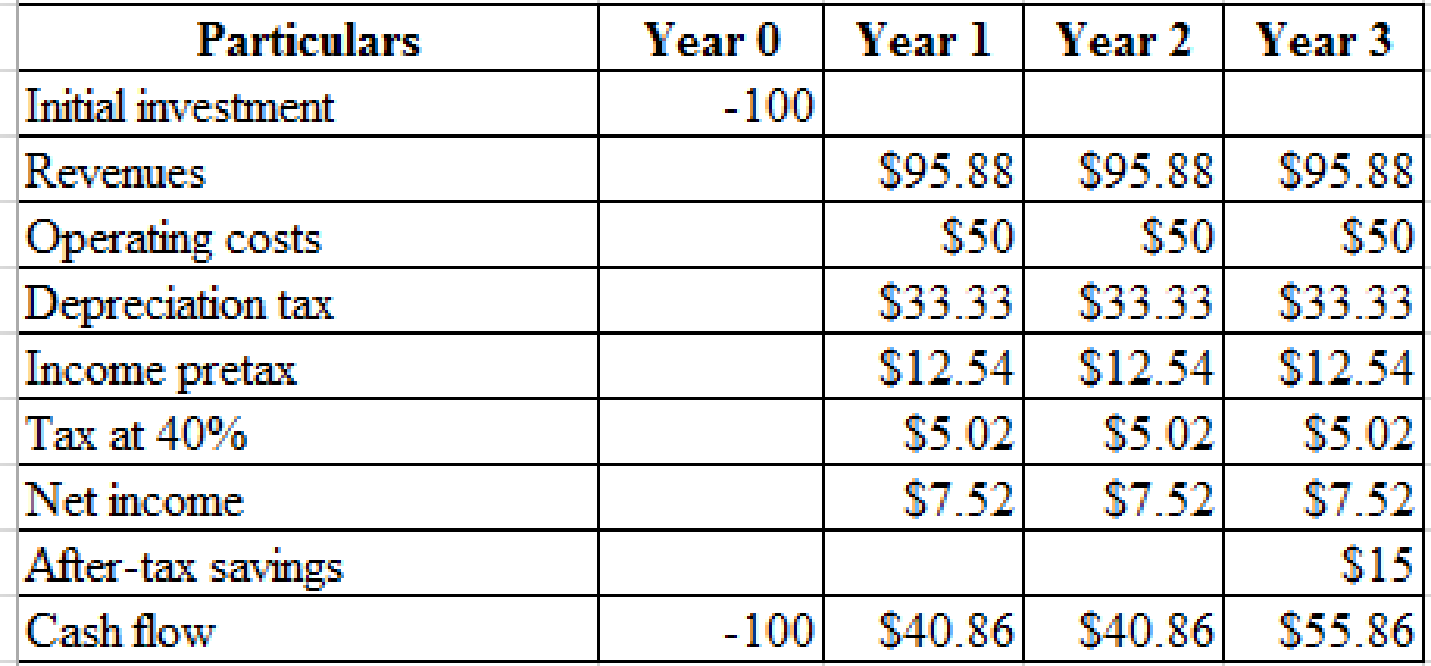
Economic rents Taxes are a cost, and, therefore, changes in tax rates can affect consumer prices, project lives, and the value of existing firms. The following problem illustrates this. It also illustrates that tax changes that appear to be “good for business” do not always increase the value of existing firms. Indeed, unless new investment incentives increase consumer demand, they can work only by rendering existing equipment obsolete.
The manufacture of bucolic acid is a competitive business. Demand is steadily expanding, and new plants are constantly being opened. Expected cash flows from an investment in a new plant are as follows:

Assumptions:
- 1. Tax depreciation is straight-line over three years.
- 2. Pretax salvage value is 25 in year 3 and 50 if the asset is scrapped in year 2.
- 3. Tax on salvage value is 40% of the difference between salvage value and
depreciated investment. - 4. The cost of capital is 20%.
- a. What is the value of a one-year-old plant? Of a two-year-old plant?
- b. Suppose that the government now changes tax depreciation to allow a 100% writeoff in year 1. How does this affect the value of existing one- and two-year-old plants? Existing plants must continue using the original tax depreciation schedule.
- c. Would it now make sense to scrap existing plants when they are two rather than three years old?
- d. How would your answers change if the corporate income tax were abolished entirely?
a)
To determine: values of one year old plant and two year old plant.
Explanation of Solution
Here, value in the sense, present value.
Calculation of present value of one-year old plant:
Hence, the present value of one-year old plant is $76.62.
Calculation of present value of two-year old plant:
Hence, the present value of two-year old plant is $48.61.
b)
To determine: Effect of government on taxes on one and two year old plant and existing plants should continue using the schedule of original tax depreciation.
Explanation of Solution
Given the industry is competitive, the investments in new plant producing the product must yields zero NPV.
Calculation of Revenues (R) at which the NPV of new plant is zero:

Hence,
By solving this, the value of R= $95.88.
By using the value of R we can calculate the present values of existing one and two years old plants.
Calculation of present value of one and two-year old plants:

Hence, the present value of one-year old plant is $72.84.
Hence, the present value of two-year old plant is $46.55
c)
To determine: Net salvage value of two year old plant.
Explanation of Solution
Calculation of salvage value:
The salvage value is $43.33.
d)
To determine: Values the corporate tax rates are abolished entirely.
Explanation of Solution
Solving for zero NPV:

By using the revenues of $90.60
Calculation of present value of one-year old plant:
Hence, the present value of one-year old plant is $79.40.
Calculation of present value of two-year old plant:
Hence, the present value of two-year old plant is $54.67
Want to see more full solutions like this?
Chapter 11 Solutions
Principles of Corporate Finance (Mcgraw-hill/Irwin Series in Finance, Insurance, and Real Estate)
- Don't used Ai solutionarrow_forwardDon't used Ai solutionarrow_forwardQuestion 25 Jasmine bought a house for $225 000. She already knows that for the first $200 000, the land transfer tax will cost $1650. Calculate the total land transfer tax. (2 marks) Land Transfer Tax Table Value of Property Rate On the first $30 000 0% On the next $60 000 0.5% (i.e., $30 001 to $90 000) On the next $60 000 1.0% (i.e., $90 001 to $150 000) On the next $50 000 1.5% (i.e., $150 001 to $200 000) On amounts in excess of $200 000 2.0% 22 5000–200 000. 10 825000 2.5000.00 2 x 25000 =8500 2 maarrow_forward
- Question 25 Jasmine bought a house for $225 000. She already knows that for the first $200 000, the land transfer tax will cost $1650. Calculate the total land transfer tax. (2 marks) Land Transfer Tax Table Value of Property Rate On the first $30 000 0% On the next $60 000 0.5% (i.e., $30 001 to $90 000) On the next $60 000 1.0% (i.e., $90 001 to $150 000) On the next $50 000 1.5% (i.e., $150 001 to $200 000) On amounts in excess of $200 000 2.0% 225000–200 000 = 825000 25000.002 × 25000 1= 8500 16 50+ 500 2 marksarrow_forwardSuppose you deposit $1,000 today (t = 0) in a bank account that pays an interest rate of 7% per year. If you keep the account for 5 years before you withdraw all the money, how much will you be able to withdraw after 5 years? Calculate using formula. Calculate using year-by-year approach. Find the present value of a security that will pay $2,500 in 4 years. The opportunity cost (interest rate that you could earn from alternative investments) is 5%. Calculate using the formula. Calculate using year-by-year discounting approach. Solve for the unknown in each of the following: Present value Years Interest rate Future value $50,000 12 ? $152,184 $21,400 30 ? $575,000 $16,500 ? 14% $238,830 $21,400 ? 9% $213,000 Suppose you enter into a monthly deposit scheme with Chase, where you have your salary account. The bank will deduct $25 from your salary account every month and the first payment (deduction) will be made…arrow_forwardPowerPoint presentation of a financial analysis that includes the balance sheet, income statement, and statement of cash flows for Nike and Adidas. Your analysis should also accomplish the following: Include the last three years of data, and evaluate the trends in the data. Summarize the footnotes on each of the statements. Compute the earnings per share for the three years. Compare the two companies and determine the insights gathered from the trend analysis.arrow_forward
- In addition to the customer affairs department of the insurance company the insurance policy must identify which other following on the policy Name of the producer Current director of insurance Policyholder satisfaction rating for paying claims 4. Financial rating from a recognized financial rating servicearrow_forwardIn addition to the customer affairs department of the insurance company the insurance policy must identify which other following on the policy Name of the producer Current director of insurance Policyholder satisfaction rating for paying claims D. Financial rating from a recognized financial rating servicearrow_forwardUnearned premium refunds for insurance policies cancelled when an insurance company is covered by the Illinois Insurance guaranty fund is subject to a MAXIMUM premium refund of what amount? A.$ 100.00 B.$ 1000.00 C.$10,000.00 D.$ 100,000.00arrow_forward
- Before the department of insurance can issue an order charging an insurance company with improper claims practices, they must first: Review the company's financial statement on file with the department Determine that the practice has been done with such frequency as to indicate a business practice Contact the company's competitors to determine if they know how the company operates Contact the NAIC to determine if the company is on the watch listarrow_forwardthe last three (3) years of the EPS and a summary of the footnotes for Nike and Adidas.arrow_forwardThe last three years of data, and evaluate the trends in the data. Summarize the footnotes on each of the statements. Compute the earnings per Include the last three years of data, and evaluate the trends in the data. Summarize the footnotes on each of the statements. Compute the earnings per share for the three years. Compare Nike and Adidas and determine the insights gathered from the trend analysis. With references PowerPoint slidesarrow_forward
 Essentials Of InvestmentsFinanceISBN:9781260013924Author:Bodie, Zvi, Kane, Alex, MARCUS, Alan J.Publisher:Mcgraw-hill Education,
Essentials Of InvestmentsFinanceISBN:9781260013924Author:Bodie, Zvi, Kane, Alex, MARCUS, Alan J.Publisher:Mcgraw-hill Education,

 Foundations Of FinanceFinanceISBN:9780134897264Author:KEOWN, Arthur J., Martin, John D., PETTY, J. WilliamPublisher:Pearson,
Foundations Of FinanceFinanceISBN:9780134897264Author:KEOWN, Arthur J., Martin, John D., PETTY, J. WilliamPublisher:Pearson, Fundamentals of Financial Management (MindTap Cou...FinanceISBN:9781337395250Author:Eugene F. Brigham, Joel F. HoustonPublisher:Cengage Learning
Fundamentals of Financial Management (MindTap Cou...FinanceISBN:9781337395250Author:Eugene F. Brigham, Joel F. HoustonPublisher:Cengage Learning Corporate Finance (The Mcgraw-hill/Irwin Series i...FinanceISBN:9780077861759Author:Stephen A. Ross Franco Modigliani Professor of Financial Economics Professor, Randolph W Westerfield Robert R. Dockson Deans Chair in Bus. Admin., Jeffrey Jaffe, Bradford D Jordan ProfessorPublisher:McGraw-Hill Education
Corporate Finance (The Mcgraw-hill/Irwin Series i...FinanceISBN:9780077861759Author:Stephen A. Ross Franco Modigliani Professor of Financial Economics Professor, Randolph W Westerfield Robert R. Dockson Deans Chair in Bus. Admin., Jeffrey Jaffe, Bradford D Jordan ProfessorPublisher:McGraw-Hill Education





